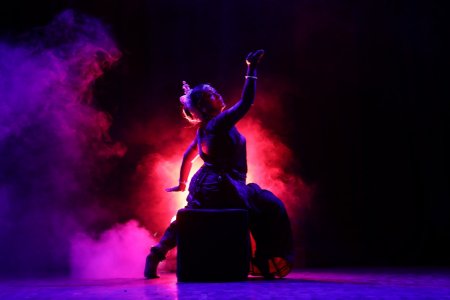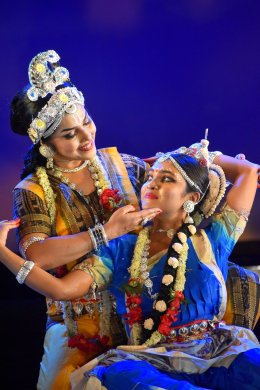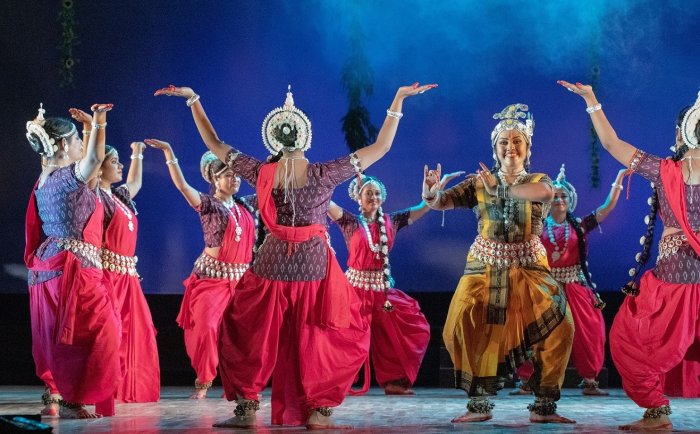
|   |

|   |
Hundredth show of Raas Leela - Tapati Chowdhurie e-mail: tapatichow@yahoo.co.in Photos courtesy: Mayur Lalit Dance Academy June 22, 2022 In collaboration with Eastern Zonal Cultural Centre, Kolkata Mayur Lalit Dance Academy gifted dance aficionados of Kolkata with a beautiful bouquet of Odissi dances and most importantly it also presented their 100th show of Raas Leela directed by Debamitra Sengupta. Guest artist from Bhubaneswar, Aruna Mohanty, was invited to perform two memorable pieces from her treasure trove. Having trained in Odissi dance by Guru Gangadhar Pradhan, she has been a student and Secretary of Orissa Dance Academy, a premiere cultural institution in Bhubaneswar. Currently Aruna Mohanty holds the post of President of Odisha Sangeet Natak Akademi. She has been entrusted by the Govt. of India and Odisha Govt. to choreograph opening ceremonies of World Cup Hockey, Asian Athletic meet and Khelo India.  Aruna Mohanty Her first presentation of the evening of June 5 at Rabindra Sadan, 'Samsar' reminded me of William Shakespeare's "Seven Ages of Man" from his drama 'As you like it', where the great poet compares the world to a stage where all the men and women are merely players who have their entries and exits. And one man in his time plays many parts, right from his infancy to old age. In the last scene of his life which ends his eventful history he reverts to his second childhood till he passes into oblivion "sans teeth, sans eyes, sans taste, sans everything". Aruna Mohanty's 'Samsar' described the journey of life through the different stages in Odissi style. There was depth of vision which leads you on to enjoy bliss. As she ended the piece in ecstasy the rapturous audience hummed with her "Bhaja Govindam Bhaja Govindam Bhaja Muddhamate..." Lyricist Kedar Mishra, with the Sanskrit text interpretation by Pt. Nityananda Mishra, to the composition of Bijaya Kumar Jena and rhythm composition by Bijaya Kumar Barik, the choreography of Aruna Mohanty reached aesthetic heights.  Aruna Mohanty The second presentation 'Pratinayaka' by Aruna Mohanty, in which she has blended Odissi with Prahalada Nataka, Sahi Jata and Geeti Natya, is a concept based on Indian aesthetics, where the hero and the anti-hero coexist. To establish the existence of the hero, the anti-hero must necessarily be there. The anti-hero is the one who has the opposite characteristics of the hero. And therefore according to Natyaveda, he is equally important. His existence defines the success of the Nayaka. "I am, therefore you are" is the moot point, which is the existential monologue of Pratinayak in every age and that is the topic which came into the purview of Aruna Mohanty. Indian mythology has different Nayaka and Pratinayaka in each era. In Satya yuga, it was Narasimha and Hiranyakashipu, in Treta yuga they were Rama and Ravana, in Dwapara, Srikrishna and Kansa. In Kali yuga, Kali and time itself is Pratinayaka. The entry of Kali in Bhagavata Mahapurana signifies the victory of truth despite the darker attack of time. Here Nayaka and Pratinayaka are synonymous with time. Every human being is the victor and the victim. Devil and divinity are represented by both Nayaka and Pratinayaka and they can be discovered in every soul, in every human being. Taken from the Bhagavata Mahapurana, the script was the result of intense research. The credit of conceptualizing this never performed subject was Kedar Mishra's. He is also the lyricist of the piece. Composer Guru Ramhari Das left no stone unturned to create a musical extravaganza to accompany the dance. The rhythm composition of Guru Dhaneswar Swain and Bijaya Kumar Barik added ambrosia to the beautiful piece. Dance was composed by Aruna Mohanty, who performed it solo for the Kolkata audience. Thinking about the cost factor, most performers dance to recorded music, but Aruna Mohanty used live music in which the accompanying artists were Bijaya Kumar Barik on mardala, Rupak Kumar Parida on vocal Agnimitra Behera on violin and Srinibas Satpathy on flute. Narrator Shreepunya Mohanty did a wonderful job. The light designer had the right expertise to create moments of awe. The excellence of the Gangadhar Pradhan style of Odissi dance has been passed down to Aruna Mohanty in the right spirit.  Debamitra Sengupta as Krishna Odissi exponent Debamitra Sengupta's Raas Leela was an extravaganza. It was truly entertaining and aroused bhakti bhava. Her keen interest in choreography has led her to experiment with unique forms like Padabali Kirtan, Sanskrit epics, classics from Bengali literature and Rabindra sahitya. She has created innovative movements and choreographed several fascinating productions in Odissi style like Chitrangada, Shyama, Shapmochan, Balya Leela, Bilwamangala, Nayanaarpanam, Numo Bharatam and of course Raas Leela which were all connoisseurs' delight. Raas Leela which celebrated its 100th performance was composed in Bengal's very own genre of music known as Padabali Kirtan, showing the joyous mood where the gopis dance with Krishna on a moonlit night of autumn beside the river Yamuna. In traditional Kirtan style, the dance drama began with 'Gourchandrika', an invocation to Sri Chaitanya Deva, an evangelist from Bengal and ends with 'Maatan' where all the bhaktas enter the stage in a Sankirtan style with khol, manjira and flowers. Sringar rasa, the love for Krishna melts into devotion between mortals and the Almighty. Raas Leela is one of the many song sequences that make up the corpus of Padabali Kirtan. Its songs depict the manner in which Krishna and Radha celebrate a festival of dance along with a bevy of gopis on a full moon night in the month of Kartick. They are symbolic of the stars in heaven that circle the sun. Debamitra's mission is to try and revive the popularity of Kirtan and at the same time, to focus the attention of the people on it. For some time now she has been doing research in the talas and rhythms of Kirtan. In Raas Leela she has used a few forgotten talas of the olden days. In her research into the talas of Kirtan, Debamitra has received valuable guidance from Brajarakhal Das, an eminent khol player. The 48 maatra Mahamantak taal is treated with Srotogata jaati to establish the Raas nritya of Krishna and the gopis. In the music of Raas Leela, Debamitra has used not only the khol but the pakhawaj as well. The two instruments were played together in duet to create a conversation between a man and a woman. The deep and rumbling notes of the pakhawaj were basically meant to represent the voice of a man, while the sweet and soft notes of the khol were intended to represent the voice of a woman. The story of 'Raas Leela' unfolded with an invocation to Sri Chaitanya Deva who initiated Vaishnavism in Bengal and its adjacent states. Invocation to Mahaprabhu Sri Sachidananda began in a traditional Sankirtan style. After that the performers moved on to a scene in Vrindavan where Lord Krishna used to dance happily with a group of gopis on the banks of river Yamuna on a full moon night of the autumn season.  Raas Leela Here, Lord Krishna challenged Radha and asked her to dance to his tune, on condition that no part of her dress should move; her anklets can make no sound. If Radha loses, Krishna will give the gopis nose rings and kanchuli; if Radha wins, the Lord will give them his flute! Radha won, leaving Krishna in a dilemma. Unable to part with his beloved flute he runs away from the gopis. But they follow him and throw a challenge at him, which is if he can dance to the rhythm that Radha does then perhaps he could be forgiven. Krishna starts dancing with Radha and the gopis, and the whole of Vrindavan enjoys the divine rhythm. The dancers then indulge in Maatan - the worshipping of Radha and Krishna's Yugalmurti with flowers and incense, to the accompaniment of khol and manjira as a part of the worship. Radha and the gopis' love for Krishna melted into their urge for unification with the Almighty. The performers lived up to the expectations of the audience. Debamitra as Krishna was charming. The show received a standing ovation. Kirtan, narration and the musical overview was by Shima Acharya Chaudhuri, Srikhol by Harekrishna Haldar and pakhawaj by Uttam Mondal. The performers who danced in Rabindra Sadan, which was bursting to the seams, were: Debomitra Sengupta (Krishna), Archita Chakraborty (Radha), Ambika Roy, Poulami Nag, Rohini Yadav, Prateeti Mukhopadhyay, Pragya Sen, Aditi Bose, Adrija Mukherjee, Shreya Banerjee, Aheli Mukherjee and other senior team members of Kolkata Mayur Lalit Dance Academy.  Tapati Chowdurie trained under Guru Gopinath in Madras and was briefly with International Centre for Kathakali in New Delhi. Presently, she is a freelance writer on the performing arts. |